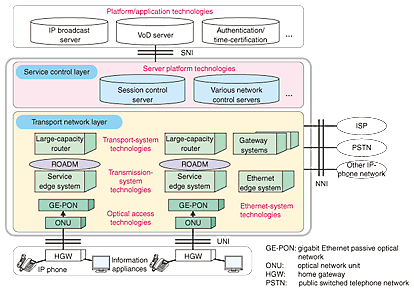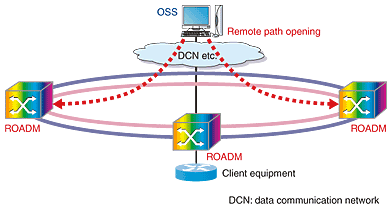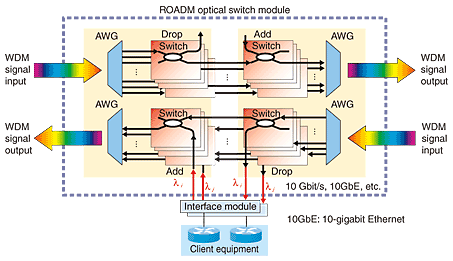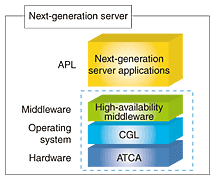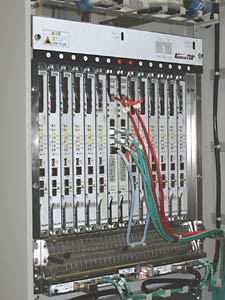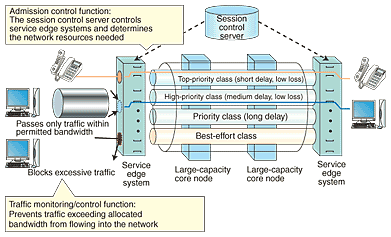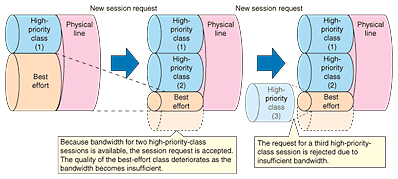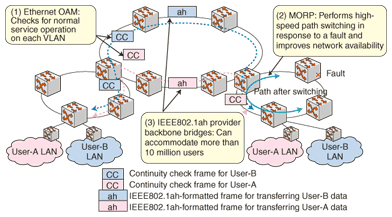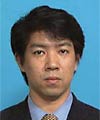 |
|||
|
|
|||
|
Special Feature: NGN Communication Styles and Support Technologies Vol. 5, No. 6, pp. 14–21, June 2007. https://doi.org/10.53829/ntr200706sf2 Network Core Technologies for a Next Generation NetworkAbstractNTT is researching and developing network core technologies for application to a next generation network (NGN). This article introduces transport-system and transmission-system technologies, server platform technologies, end-to-end quality-control technologies, and Ethernet-system technologies as four important core technologies for the NGN.
1. IntroductionNTT is committed to building a next generation network (NGN) that combines the high-quality, reliability, and security features of NTT's legacy fixed telephone network with the advantages of an IP (Internet protocol) network such as multi-service support and economy of scale. For this purpose, NTT envisions a network that uses a layered structure model to accommodate technical innovations and high-speed, diverse services while adopting an architecture that conforms to the NGN standards and specifications. Furthermore, to enable various players to provide diverse application services and achieve an open network that ensures mutual connectivity with other operator's IP networks, NTT plans to disclose interface specifications. This article introduces important network core technologies that NTT Laboratories is developing for application to the NGN. 2. Overview of network core technologiesAn overview of network core technologies now being pursued at NTT Laboratories is shown in Fig. 1. NTT envisions the NGN as consisting of a transport network layer and service control layer and having three types of interfaces: the user-network interface (UNI) between the optical-access system and user terminals, the network-network interface (NNI) between NTT and other operators, and the application server-network interface (SNI: interface between an application server and the network) that connects the NGN with the application-servers. When interconnecting with other operators, NTT expects its NGN to connect not only to other telephone networks and Internet service providers (ISPs) but also to other NGNs by means IP.
Core technologies being developed for the transport network include technologies for optical access systems, service edge systems, Ethernet edge systems, large-capacity routers, gateway systems for interconnecting to other operators, and various transmission systems. Those being developed for the service control layer include technologies for server systems such as session-control servers. 2.1 Transport-system technologiesThe transport network in the NGN must be sufficiently extendible to accommodate tens of millions of broadband optical-access users, must have quality-control functions to provide diverse application services each with its own quality requirements, and must be highly secure to combat unauthorized access and other malicious behavior. The following technologies are important to meet these requirements. –A simple, hierarchical network supporting scalability and an extendible routing design that provides IPv4/IPv6 connectivity. –Quality-control functions that can manage network bandwidth on a session-by-session basis and that can allocate resources as needed. –Topology-hiding functions for interconnecting with networks of other operators. NTT is investigating a hierarchical network consisting of large-capacity core routers and service edge systems as the main constituent elements of the transport network. To support massive broadband traffic in the years to come, large-capacity core routers are envisioned to support terabit-per-second-class throughput and system-level redundancy. NTT is also investigating a network design for achieving a simple and high-reliability network with the minimum number of layers by arranging these large-capacity core routers in network-level redundancy to raise reliability even more. As for routing, a routing design is being investigated to provide IPv4/IPv6 dual connectivity having the same logical topology and routing system for both protocols, with extendible features to accommodate the spread of IPv6. Furthermore, with the aim of providing large-scale and high-reliability IP broadcast services, NTT is performing studies on a multicast routing system that incorporates a two-route redundant configuration on the network level to improve reliability. The above measures are expected to accommodate ever increasing amounts of traffic in an efficient manner. The idea here is to reduce the capital and operating expenses while making an extendible large-scale network. NTT also envisions a set of quality-of-service (QoS) classes to support communication services with diverse requirements in the NGN and is investigating systems such as Diffserv (differentiated services) that apply priority-control techniques to IP-packet transfer. Specifying QoS classes enables traffic having strict requirements in terms of packet loss, delay, and jitter to be handled in an efficient manner. A service edge system is where packets flowing into the network are classified into different QoS classes. It sends them into the network while controlling packet transfer in accordance with the priority levels of those QoS classes. It is also where unauthorized access to high-prioritized QoS classes and traffic that would exceed expectations on a call-by-call basis are blocked. Here, information on QoS classes for each call and assumed traffic bandwidth will be conveyed to the service edge system from the session control server that manages traffic for each quality class. The end-to-end quality-control system that will serve as a network for linking the service edge system and session control server is described in section 2.4. The provision of similar quality-control functions for gateway systems that interconnect to other operators is also under study. Countermeasures against unauthorized access at a service edge system and topology-hiding functions for gateway systems to other operators are considered to be useful for ensuring security in the NGN. The application of fast fault recovery technologies and traffic engineering technologies is also being studied with the aim of making the network even more reliable and efficient. 2.2 Transmission-system technologiesThe capacity of the backbone optical network must be increased in order to achieve a large-scale NGN by combining the large-capacity core routers and service edge systems described above. In particular, considering that the conventional ring format is being applied as a transmission-path topology in areas where distributed nodes can be efficiently connected by optical fiber, it will be necessary to develop a large-capacity, cost-efficient optical ring system to support the traffic demands of the future NGN. To this end, NTT is developing a reconfigurable optical add/drop multiplexer (ROADM) based on dense wavelength division multiplexing (DWDM) technology to provide a large-capacity optical ring system that will be able to multiplex several tens of wavelengths in one optical fiber. At present, one wavelength can accommodate a 10-Gbit/s signal. Technology is now being tested for a sub-terabit system (several hundred gigabits per second) in terms of total ROADM transmission capacity. This will make it possible to configure a ring plane with a ring length of several hundred kilometers. A major feature of ROADM is its compact, high-reliability, low-loss built-in, planar lightwave circuit ROADM optical switch, which was developed by NTT Laboratories. This achieves low-cost operation by adding/dropping optical signals in units of wavelengths instead of performing electrical/optical conversions. A typical configuration of an ROADM system is shown in Fig. 2. Here, ROADM nodes are connected by optical fiber in a ring topology and are monitored and controlled by an operations support system (OSS). In addition to enabling all optical paths in the ring to be monitored together, this ROADM system enables control instructions to be given to each ROADM optical switch from the OSS terminal and path openings to be set from a remote location if a new traffic demand arises. This can be extremely effective in preventing the occurrence of faults caused by erroneous extraction or connection of optical fibers. A system of this type is also capable of monitoring multiple ring systems at one time.
The configuration of the ROADM optical switch module is shown in Fig. 3. After an input WDM signal has been divided into multiple optical signals of different wavelengths using an arrayed waveguide grating (AWG), an optical switch can be set to drop certain wavelengths at that the ROADM, forward certain wavelengths to the next ROADM, or set optical wavelengths input at that ROADM to certain wavelengths before sending them off to the next ROADM. The AWG and optical switch are based on planar lightwave circuit technology, which offers the advantages of a small size and high reliability.
Looking to the future, NTT is working to improve the wavelength multiplicity, increase the transmission distance, and improve OSS operability of the ROADM by taking advantage of the cutting edge optical technology emerging from NTT's R&D. 2.3 Server platform technologiesCommunication control servers within a carrier network have traditionally been required to (1) ensure a high level of reliability and availability as demanded by a large-scale network, (2) reduce facility investment and operation costs significantly, (3) provide extensive maintenance and operation functions, and (4) facilitate facility upkeep and upgrading. Protocol processing at NGN session control servers situated between terminals and servers is expected to become more diverse and complicated as the demand for diverse broadband services grows. At the same time, the realtime control of network equipment for achieving end-to-end quality control and other essential functions is becoming increasingly important to network services. Furthermore, to enable a level of stability on par with that of the traditional telephone system to be provided, NGN session control servers are required, especially for the severe requirements of processing performance, extendibility, reliability, and other characteristics described above. Despite this situation, the hardware, operating system, middleware, and other platforms making up existing session control servers (such as SIP servers) have been centered around the proprietary products of system vendors. This has generated concern about the increasing dependency on supply vendors due to the black-box nature of proprietary products, the frequency of generation upgrades, and lack of stable supply. In response to these issues, NTT is working to develop open-platform technology for session control servers in the NGN with the aim of satisfying the above requirements. Specifically, it is promoting studies on a next-generation server platform using the advanced telecommunications computing architecture (ATCA), which is a general-purpose hardware platform technology; Carrier Grade Linux, which is an open-source operating system; and high-availability middleware (Fig. 4).
ATCA, which is being standardized at PICMG (PCI (peripheral component interconnect) Industrial Computer Manufacturers Group: a consortium for establishing open hardware specifications toward high performance in computers and telecommunication equipment), is a hardware standard for high-performance systems used by telecommunication carriers. It has the following benefits: (1) Leads to lower prices as a result of competition among multiple suppliers of products based on global standards and specifications and ensures stable supplies because products are available from multiple vendors. (2) Facilitates functional extendibility through the implementation of new functions (i.e., the addition of modules) and improves board compatibility between product generations (3) Enhances reliability, maintainability, and availability by using carrier-grade standards –Achieves high reliability and high availability by using redundant configurations of power supplies, fans, and other components –Improves maintainability through the use of hot-swappable blade servers, maintenance that can be performed from the front, and so on. An implementation of server shelves based on ATCA standards is shown in Fig. 5.
Carrier Grade Linux adds various functions to ordinary Linux so that it can be used in the demanding environment of a telecommunications carrier. Being open-source, it is fundamentally license-free, which means cost reductions, and the feedback received from many researchers and engineers during the problem discovery and countermeasure design phases tends to make the software mature rapidly. Finally, high-availability middleware can provide functions like inter-system memory synchronization and other-system monitoring that have traditionally been performed by dedicated hardware in telephone switching systems. It can also incorporate file-update functions, backup functions, and restart functions (including escalation functions) enabling high-reliability and high-availability performance on a level equivalent to that of telephone switching systems. NTT is studying the use of Carrier Grade Linux and high-availability middleware with the aim of achieving a system that satisfies the reliability, availability, maintainability, and performance levels required by telecommunication carriers. 2.4 End-to-end quality controlNTT sees the NGN as providing applications such as bidirectional (interactive) communications featuring high-quality audio and video and multicast delivery of high-definition television (HDTV). In contrast to conventional best-effort communications, communication services like these will maintain transmission quality during a communication session by allocating the required network bandwidth to that session. The technology for quality control of communications is outlined below. End-to-end quality control consists of two functions: an admission control function to enable the network bandwidth necessary for communications to be allocated and a traffic monitoring/control function (Fig. 6).
There are two main methods for allocating the network bandwidth needed for a communication session: (1) static allocation that allocates a fixed amount of bandwidth constantly and (2) dynamic allocation that allocates the required network bandwidth every time a communication session begins. The best method to choose depends on the usage pattern of the communication service. In dynamic allocation, a situation may arise in which necessary network bandwidth cannot be allocated at the beginning of the session due to network conditions such as temporary congestion, causing the call to be lost. The network design process should consider the demand for services and the above two types of bandwidth-allocation methods. In particular, for communication services that use dynamic bandwidth allocation, network resource design should take into account quality targets for the call loss probability. The traffic monitoring/control function monitors packet quantity and quality class in each communication session that has been allocated bandwidth, and it ensures that only traffic within the specified bandwidth flows into the network. The following presents an example of end-to-end quality control for interactive communications using session initiation protocol (SIP). This protocol has found widespread use as a means for one terminal to call another terminal when seeking an interactive session and for enabling those terminals to exchange information about media format, network bandwidth, etc. To begin with, a terminal that wishes to interact with another terminal uses SIP to pass information about call destination, media format, necessary bandwidth, etc. to a session control server within the network. Next, the admission control function of the session control server checks the state of resources within the network based on the information provided, allocates the network bandwidth needed by those two terminals, and proceeds to establish a session between the terminals. The admission control function also passes key information such as data for identifying the session, the bandwidth to be used, and the quality class, to the service edge system. At this point, the service edge system starts up the traffic monitoring/control to handle all subsequent communications. Upon session completion, the session control server instructs the service edge system to terminate monitoring and control. If, on the other hand, necessary resources cannot be secured by the session control server when it receives a session request from a terminal, the procedure for establishing a session between terminals will be terminated. An example showing how the use of network bandwidth can change over time is shown in Fig. 7. Initially, there is one high-priority-class session in progress. The request for a second high-priority-class session is accepted, but the request for the third one is rejected.
End-to-end quality control is a new technology being developed and applied for the NGN. NTT plans to conduct more studies with the aim of achieving more freedom in service expansion while increasing the efficiency of network use. This will require the collection of both technologies and knowledge, including traffic-data gathering methods, network design methods, quality-related needs, and traffic trends. 2.5 Ethernet-system technologiesWide-area Ethernet services are a type of virtual private network (VPN) service for connecting enterprise sites. Using inexpensive layer-2 switches as transport devices, they can provide a wide-area network at low cost. The spread of wide-area Ethernet services has revealed, however, that coping with an increasing number of users and improving network reliability are problems that need to be addressed. To solve these problems, NTT Laboratories is studying the following three technologies for wide-area Ethernet services for the NGN (Fig. 8).
(1) Ethernet OAM NTT is studying the use of Ethernet operation, administration, and management (OAM), which is now being standardized at ITU-T (International Telecommunication Union Telecommunication Standardization Sector) and IEEE, to improve end-to-end maintenance and operating characteristics and network reliability in wide-area Ethernet services for the NGN. In contrast to conventional Ethernet technologies, which do not prescribe network-monitoring methods as needed by wide-area network (WAN) services, Ethernet OAM prescribes functions such as "continuity check" for sending and receiving test frames between switches at regular intervals, "loop back" for checking continuity between switches as in the IP ping function, and "link trace" for determining a path as in the IP traceroute function. The sending and receiving of Ethernet OAM test frames between switches in a virtual local area network (VLAN) on a VLAN basis enables faults to be detected within a particular VLAN. The "continuity check" in particular is attracting attention as a means of checking for normal service operation by periodically sending and receiving test frames between switches that serve users. (2) Multiple open rings protocol NTT is researching redundant-configuration technologies based on its multiple open rings protocol (MORP) so that detours can be made around points where faults have occurred in the network by automatically switching paths. The aim here is to minimize service downtime for users. When conventional path-switching techniques are applied to large-scale networks, a recovery time of several tens of seconds to several minutes is needed after a fault occurs, which results in a period of instability until a path can be found. With MORP, faults can be detected early by having adjacent switches exchange test frames at short intervals. Furthermore, since path switching to detour around faults can be done autonomously by switches connected in a ring format, MORP enables fault recovery to be performed automatically and quickly. This keeps service downtime to less than one second and improves network availability. (3) IEEE802.1ah provider backbone bridges Finally, NTT is studying the use of the IEEE802.1ah standard for large-scale VLANs to enable even more users to share switches and relay circuits that transfer Ethernet frames. Conventional wide-area Ethernet services have been using the IEEE802.1ad standard, which allows a maximum of only 4094 individual user networks to share switches and circuits. If this number is exceeded, separate switches and circuits become necessary. IEEE802.1ah, in contrast, allows more than 10 million user networks to share switches and circuits. In addition, user frames in an IEEE802.1ah network are encapsulated, which means that they can be transferred by referring to dedicated network destination addresses. This reduces the number of addresses that must be handled by switches in the network, making for smaller processing loads. For the future, NTT plans to promote the establishment of the technologies introduced here and to actively pursue their standardization. 3. ConclusionThis paper introduced four core technologies that NTT is researching and developing for application to the next generation network: transport-system and transmission-system technologies, server platform technologies, end-to-end quality-control technologies, and Ethernet-system technologies. NTT continues to investigate technology elements such as functionality and reliability to make further improvements in each technology field. |
|||








